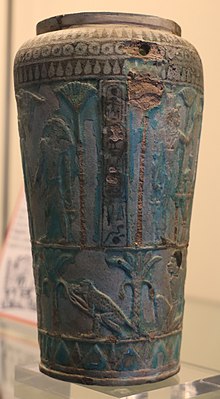Bocchoris vase
The Bocchoris vase (also Bokchoris vase ) was found in an Etruscan tomb in Tarquinia in 1895 and is now in the Museo Archeologico Nazionale Tarquiniense (inventory number RC 2010). The vase, sometimes referred to as the situla in the literature , is 22.2 cm high and 12.5 cm in diameter. It is made of Egyptian faience . On the outside there is a relief decoration in two registers. The upper register shows two cult scenes. The first shows an Egyptian king standing between the goddess Neith and the god Horus . In the second scene one again sees the king, who is led by Thoth to Horus. In the lower register several kneeling and handcuffed Nubian prisoners are shown. Again in the upper register there is a vertical inscription, which names the throne and birth name of the Egyptian pharaoh (king) Wah-ka-Re Bakenrenef . This ruler ruled around 720 to 716 BC. And is referred to in Greek sources as Bokchoris ( ancient Greek Βόκχορις ). That is why the vase got its modern name.
The place of manufacture of the vase is controversial in research. On the one hand, it is believed that the vase was produced in Phenicia . On the other hand, it is suggested that it was made in Egypt and then negotiated to Etruria .
Individual evidence
- ↑ Beatrice Casocavallo, in: Joan Aruz, Sarah Graff, Yelena Rakic (eds.): Assyria to Iberia: At the Dawn of the Classical Age. Metropolitan Museum of Art, New York / New Haven 2014, ISBN 978-0-300-20808-5 , pp. 318-319, no. 187.
- ^ Günther Hölbl : Relations between Egyptian culture and ancient Italy: text part. Brill, Leiden 1979, ISBN 900-405487-1 , pp. 89-92.
